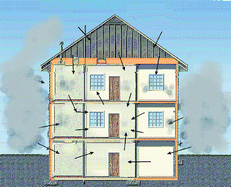As part of the Brooklyn Traffic Real-Time Ambient Pollutant Penetration and Environmental Dispersion (B-TRAPPED) study, a field investigation was conducted of the mechanisms involved in infiltration of outdoor particles (0.02 μm to 1 μm) into a near-highway urban residential building. Using continuous real-time total number concentration time-series data measured simultaneously at multiple outdoor and indoor locations, the infiltration time was estimated for various indoor sites by using the cross-correlation analysis method.
The effects of meteorological variables on infiltration times were also characterized at given locations. In particular, infiltration time was examined as a function of outdoor mean rooftop wind speed. Outdoor and indoor temperature and relative humidity were also investigated in relation to infiltration times. Our results showed that outdoor wind speed was the dominant meteorological parameter affecting the infiltration rate, but no correlation was found with temperature. The outdoor–indoor PM concentration ratio was found to be significantly different for the first and second floors of the test building. Finally, we determined the effectiveness of a protective shelter-in-place area inside the building by calculating infiltration times into the area. We found that the shelter-in-place area offered some protection against the infiltrating particles because of increased attenuation of the outdoor concentration.

You have access to this article
 Please wait while we load your content...
Something went wrong. Try again?
Please wait while we load your content...
Something went wrong. Try again?


 Please wait while we load your content...
Please wait while we load your content...